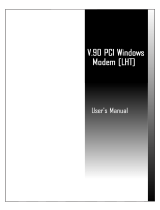
5.4 Windows 95
Windows 95 maintains a registry of all known hardware installed
in your computer. Inside this hardware registry Windows 95 keeps track
of all of your system resources, such as I/O locations, IRQ levels, and
DMA channels. The "Add New Hardware Wizard" utility in Windows 95
was designed to add new hardware and update this registry.
An "INF" configuration file is included with the ESC(LP)-100 to
allow easy configuration in the Windows 95 environment. Also a custom
Windows 95 serial device driver is included with the ESC(LP)-100 to
support the use of the 16750 UART's 64 byte fifo.
5.4.1 Using the "New Hardware Found" Wizard
The following instructions provide step-by-step instructions on
installing the ESC(LP)-100 in Windows 95 using the "New Hardware
Found" wizard.
1. After booting the computer with a newly-installed ESC(LP)-100,
the "New Hardware Found" dialog box will appear. If you have
never installed a Quatech PCI communications adapter before, the
dialog box may simply indicate that it has found a "PCI Card."
2. Select the radio button for "Driver from disk provided by hardware
manufacturer." Click the "OK" button to continue.
3. An "Install From Disk" dialog box should pop up. Insert the
diskette with the Quatech INF files on it, select the correct drive
letter, and click the "OK" button. Windows 95 automatically
browses the root directory for an INF file that defines
configurations for Multi-function Adapters. If no INF files are
found, click the "Browse" button and search the Win95 sub
directory on the installation diskette. You are not required to select
the file name. After finding the directory containing the INF files,
Windows 95 will choose the correct file.
4. The "New Hardware Found" dialog box will appear again, this
time for an "Unknown Device."
5. Again select the radio button for "Driver from disk provided by
hardware manufacturer." Click the "OK" button to continue.
6. Another "Install From Disk" dialog box will pop up. The path
should already be pointing to the Quatech diskette. Click the "OK"
button to continue.
ESC(LP)-100 User's Manual 12




















